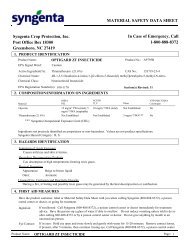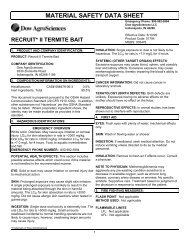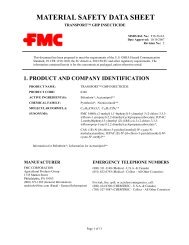Specimen Label
Specimen Label
Specimen Label
You also want an ePaper? Increase the reach of your titles
YUMPU automatically turns print PDFs into web optimized ePapers that Google loves.
<strong>Specimen</strong> <strong>Label</strong><br />
RESTRICTED USE PESTICIDE DUE TO<br />
INHALATION TOXICITY<br />
For sale to and use only by Certified Applicators or persons under<br />
their direct supervision and only for those uses covered by the Certified<br />
Applicator’s certification.<br />
Keep Out of Reach of Children<br />
PELIGRO<br />
Precaucion al usuario: Si usted no lee inglés, no use este producto<br />
hasta que la etiqueta le haya sido explicada ampliamente.<br />
Extremely Hazardous Liquid And Vapor Under Pressure • Inhalation<br />
of Vapors May Be Fatal • Liquid May Cause Freeze Burns of<br />
Exposed Skin<br />
Do not get in eyes, on skin, or on clothing. Vikane* gas fumigant is<br />
odorless. Exposure to toxic levels may occur without warning or<br />
detection by the user.<br />
For control of: Existing infestations of insects and<br />
related pests such as (or including) drywood termites,<br />
Formosan termites, powder post beetles, death watch<br />
beetles, old house borers, bedbugs, cockroaches,<br />
clothes moths, rodents (rats, mice), and the larvae and<br />
adults of carpet beetles (except egg stage), oriental,<br />
American, and brown-banded cockroaches.<br />
For use in: Dwellings (including mobile homes),<br />
Buildings, Construction Materials, Furnishings<br />
(household effects), and Vehicles including<br />
automobiles, buses, surface ships, rail cars, and<br />
recreational vehicles (but not including aircraft).<br />
When fumigating, observe local, state, and federal rules and<br />
regulations including such things as use of chloropicrin, clearing<br />
devices, positive-pressure self-contained breathing apparatus,<br />
security requirements, and placement of warning signs.<br />
Active Ingredient<br />
sulfuryl fluoride .................................................................. 99.8%<br />
Inert Ingredients ........................................................................ 00.2%<br />
Total ......................................................................................... 100%<br />
EPA Reg. No. 62719-4<br />
Precautionary Statements<br />
Hazards to Humans and Domestic Animals<br />
First Aid<br />
In all cases of overexposure, such as nausea, difficulty in breathing,<br />
abdominal pain, slowing of movements and speech, numbness in<br />
extremities, get medical attention immediately. Take person to a doctor<br />
or emergency treatment facility.<br />
If Inhaled: Get exposed person to fresh air. Keep warm and at rest.<br />
Make sure person can breathe freely. If breathing has stopped, give<br />
artificial respiration. Do not put anything in the mouth of an unconscious<br />
person.<br />
If Liquid Is On Skin: Immediately apply water to contaminated area of<br />
clothing before removing. Once area has thawed, remove contaminated<br />
clothing, shoes, and other items covering skin. Wash contaminated skin<br />
area thoroughly or shower.<br />
If Liquid Is In Eyes: Flush with plenty of water for at least 5 minutes.<br />
Get medical attention.<br />
Note to Physician: Vikane is a gas which has no warning properties<br />
such as odor or eye irritation. (However, chloropicrin is used as a<br />
warning agent and is a known lachrymator). Early symptoms of<br />
exposure to Vikane are respiratory irritation and central nervous<br />
system depression. Excitation may follow. Slowed movement, reduced<br />
awareness, and slow or garbled speech may be noted. Prolonged<br />
exposure can produce lung irritation, pulmonary edema, nausea, and<br />
abdominal pain. Repeated exposure to high concentrations can result<br />
in significant lung and kidney damage. Single exposures at high<br />
concentrations have resulted in death. Treat symptomatically.<br />
Liquid Vikane in the eye may cause damage due to refrigeration or<br />
freezing.<br />
Notice: Read the entire label. Use only according to label directions.<br />
Before buying or using this product, read “Warranty Disclaimer”<br />
and “Limitation of Remedies” elsewhere on this label.<br />
In case of emergency endangering health or the environment involving<br />
this product, call 1-800-992-5994. If you wish to obtain additional product<br />
information, visit our web site at www.dowagro.com.<br />
Agricultural Chemical: Do not ship or store with food, feeds, drugs or<br />
clothing.<br />
Directions for Use<br />
It is a violation of Federal law to use this product in a manner inconsistent<br />
with its labeling.<br />
Read all Directions for Use carefully before applying.
Storage and Handling<br />
Store in dry, cool, well ventilated area under lock and key. Post as a<br />
pesticide storage area. Do not contaminate water, food, or feed by<br />
storage.<br />
Store cylinders upright; secured to a rack or wall to prevent tipping.<br />
Cylinders should not be subjected to rough handling or mechanical shock<br />
such as dropping, bumping, dragging, or sliding. Do not use rope slings,<br />
hooks, tongs, or similar devices to unload cylinders. Transport cylinders<br />
using hand truck or fork truck to which the cylinder can be firmly secured.<br />
Do not transport any cylinders in closed vehicles where they occupy the<br />
same common airspace as personnel. Transport securely only in an<br />
upright position.<br />
Do not remove valve protection bonnet and safety cap until immediately<br />
before use. Replace safety cap and valve protection bonnet when<br />
cylinder is not in use.<br />
When cylinder is empty, close valve, screw safety cap onto valve outlet,<br />
and replace protection bonnet before returning to supplier. Only the<br />
registrant is authorized to refill cylinders. Do not use cylinder for any<br />
other purpose. Follow registrant’s instructions for return of empty or<br />
partially empty cylinders.<br />
Leak Procedures: Evacuate immediate area of leak. Use a NIOSH or<br />
MSHA approved positive pressure self-contained breathing apparatus<br />
(SCBA, not SCUBA) or combination air-supplied/SCBA respirator, such<br />
as manufactured by Ranger, Survivair, Scott, or MSA, for entry into<br />
affected areas to correct problem. Move leaking or damaged cylinder<br />
outdoors or to an isolated location, observing strict safety precautions.<br />
Work upwind if possible. Do not permit entry into leakage area by<br />
unprotected persons until concentration of fumigant is determined to<br />
be 5 parts per million (ppm) or less, as determined by a detection<br />
device with sufficient sensitivity such as an INTERSCAN or MIRAN gas<br />
analyzer. For more detailed information on the source and use of air<br />
monitoring devices or respirators, consult the Vikane Gas Fumigant<br />
Structural Fumigation Manual.<br />
Cylinder and Product Disposal: Promptly return all empty cylinders<br />
to your distributor of Vikane. Follow proper cylinder handling directions<br />
above.<br />
Pesticide wastes are toxic. Improper disposal of excess pesticide is<br />
a violation of Federal law. If these wastes cannot be disposed of by<br />
use according to label instructions, consult your State Pesticide or<br />
Environmental Control Agency, or the Hazardous Waste Representative<br />
at the nearest EPA Regional Office for guidance.<br />
General Information<br />
Before using, read and follow all label precautions and directions. Prior<br />
to the parties entering into a fumigation agreement, the Fact Sheet for<br />
Vikane must be provided to an adult occupant of the structure to be<br />
fumigated.<br />
Vikane is a highly hazardous material and should be used only by<br />
individuals knowledgeable of the hazards of this chemical and trained in<br />
the use of required respiratory equipment, detector devices, emergency<br />
procedures, and in the proper use of this fumigant.<br />
When used for fumigation of enclosed spaces, such as houses and other<br />
structures, warehouses, vaults, chambers, trucks, vans, boxcars, ships,<br />
and other transport vehicles, 2 persons trained in the use of this product,<br />
at least one being an applicator that is licensed/certified by the state,<br />
must be present at all times during introduction of fumigant, reentry prior<br />
to aeration, and during the initiation of the initial aeration procedure<br />
when exposure exceeds 5 ppm. Two persons need not be present<br />
if monitoring is conducted remotely (outside the area being<br />
fumigated).<br />
If fumigating for insect pests, do not apply when temperature at<br />
site of pest activity is below 40°F. This temperature may be<br />
measured at the slab foundation, sub-floor soil, or wherever the<br />
coolest part of the structure may be. This restriction does not<br />
apply when fumigating for rodents.<br />
When fumigating a single unit/room within or connected to a larger<br />
structure (such as town houses, apartments, condominiums) all units of<br />
the entire structure must be vacated during the fumigation and aeration<br />
periods.<br />
Remove edible items from the structure before the fumigation if they<br />
cannot be adequately sealed to prevent exposure to Vikane. Chloropicrin<br />
must be used as described on the label to warn of an ongoing fumigation.<br />
Preparation for Fumigation<br />
Structural Fumigation<br />
Remove from the structure to be fumigated all persons, domestic<br />
animals, pets, including fish, and desirable growing plants. Remove<br />
mattresses (except waterbeds) and pillows completely enveloped in<br />
water proof covers or remove covers. Food, feed, drugs, and medicinals<br />
(including those items in refrigerators and freezers) can remain in the<br />
structure if they are in plastic, glass, or metal bottles, cans, or jars with<br />
the original manufacturer’s air-tight seal intact. Food, feed, drugs,<br />
and medicinals (including those items in refrigerators and freezers)<br />
not in plastic, glass, or metal bottles, cans, or jars with the original<br />
manufacturer’s air-tight seal intact, need to be removed from the<br />
fumigation site, or double bagged in Nylofume* bags, which are<br />
available from distributors of Vikane gas fumigant.<br />
Note: Extinguish all flames, including pilot lights of water heaters,<br />
gas refrigerators, ranges, ovens, broilers, etc. Turn off or unplug all<br />
electrical heating elements such as those in heaters, pianos, organs,<br />
etc. Shut off automatic switch controls for appliances and lighting<br />
systems which will be included in the space to be fumigated.<br />
Open operable internal doors, internal openings to attics and sub areas,<br />
storage chests, cabinets, drawers, closets, and appliances (such as<br />
washers, dishwashers, dryers, microwave or conventional ovens, etc.).<br />
Using electric fan(s) will help provide for forced distribution and aeration<br />
of basements and other dead air spaces to facilitate rapid dispersion<br />
of gas. Refrigerator and freezer doors may be left open if the units are<br />
turned off or disconnected and all food items have been removed. If the<br />
applicator chooses to leave sealed food items in closed refrigerators and<br />
freezers during the fumigation, the appliances should be opened when<br />
clearing the structure until the concentration of Vikane in them is 5 ppm<br />
or less.<br />
Tarpaulin Fumigation<br />
Open operable windows. When tarping, use a highly resistant material<br />
such as a vinyl coated nylon, or polyethylene sheeting of at least 4 mil<br />
thickness. Seal all seams. Seal all low edges of the cover (such as with<br />
soil, sand, or weighted “snakes”). To minimize escape of gas through the<br />
soil and to avoid injury to nearby plants, wet soil outward from foundation<br />
to the cover if not sufficiently moist to act as a barrier for the gas.<br />
Taped Fumigation<br />
For fumigation sites that can be sealed with plastic, paper, or tape, seal<br />
adequately around doors, windows, vents, and other openings.<br />
2 <strong>Specimen</strong> <strong>Label</strong> Revised 03-15-00
Chamber Fumigation<br />
For chamber fumigation use a gas-tight chamber with adequate<br />
circulation.<br />
Construction Materials, Furnishings<br />
(Household effects), and Vehicles<br />
Follow preparations as appropriate in above paragraphs for chamber,<br />
taped fumigation, or tarpaulin fumigation to assure good confinement<br />
of the gas for the recommended period of exposure.<br />
Fumigation of Surface Ships in Port<br />
Surface ships in size up to and including large ocean-going ships<br />
may be fumigated with Vikane to control the various pests listed. The<br />
professional fumigator and the ship’s captain (or owner) shall follow<br />
all applicable regulations including those listed in the Department of<br />
Transportation, Chapter 1, Parts 147A.1-147A.43. Except for those<br />
persons involved in fumigation, no people, plants, or pets may be onboard<br />
during fumigation.<br />
The person responsible for the fumigation must notify the master of the<br />
vessel, or his representative, of the requirements relating to personal<br />
protection equipment and detection equipment. Emergency procedures,<br />
cargo ventilation, periodic monitoring and inspections, and first aid<br />
measures must be discussed with and understood by the master of<br />
the vessel or his representative.<br />
If leakage of the fumigant is detected, the person in charge of the<br />
fumigation shall take action to correct the leakage, or shall inform<br />
the master of the vessel, or his representative, of the leakage so that<br />
corrective action can be taken.<br />
Edible commodities shall not be exposed to the chemical. If not removed<br />
from the vessel they shall be protected from exposure. The vessel must<br />
not be moved during the fumigation and aeration periods. If reentry is<br />
necessary before aeration is completed, positive pressure self-contained<br />
respiratory protection must be worn.<br />
Warning Agent<br />
Chloropicrin is a warning agent introduced into the structure during<br />
fumigation. In order to avoid direct exposure to the fumigant being<br />
released, chloropicrin must be released within the structure at least<br />
5 to 10 minutes prior to introduction of the fumigant. Place a handful<br />
of wicking agent, (e.g., cotton) in a shallow chloropicrin evaporation<br />
container. Do not use chloropicrin evaporation containers or application<br />
equipment made of magnesium, aluminum, or their alloys, as chloropicrin<br />
may be severely corrosive to such metals. To enhance the distribution<br />
of chloropicrin throughout the structure, place the shallow chloropicrin<br />
evaporation container in the air stream of a fan. Pour chloropicrin over<br />
the wicking agent. When adding chloropicrin to evaporation containers,<br />
dispense no more than 3 fluid ounces per container. Use 1 fluid oz/<br />
10,000 to 15,000 cubic feet - (30 ml/283 to 425 cubic meters) of space<br />
to be fumigated. Establish at least one chloropicrin introduction site<br />
for each 45,000 cubic feet of space to be fumigated. Removal of all<br />
chloropicrin evaporation containers from the fumigated space during<br />
Step 1 of the “Aeration Procedure 1” will aid in the dissipation of the<br />
warning agent from the structure.<br />
Chloropicrin need not be used when fumigating railcars; however, a<br />
thorough walk-through inspection must be performed of each railcar with<br />
doors being immediately locked upon leaving each car, and a guard must<br />
be posted during fumigant introduction, exposure period, and aeration.<br />
Chloropicrin is a warning agent which causes smarting of the eyes, tears,<br />
and discomfort, and has a very disagreeable pungent odor at very low<br />
concentrations. Chloropicrin must be used by a persons certified to<br />
apply Vikane or under their supervision. Fumigators must observe the<br />
precautionary statements and safety recommendations appearing<br />
on the label of this product.<br />
Protective Clothing<br />
Wear goggles or full face shield for eye protection during introduction of<br />
the fumigant. Do not wear gloves or rubber boots. Do not reuse clothing<br />
or shoes that have become contaminated with liquid Vikane until<br />
thoroughly aerated and cleaned.<br />
Respiratory Protection<br />
If the concentration of Vikane in the fumigated area (as measured by a<br />
detector device with sufficient sensitivity such as an INTERSCAN or<br />
MIRAN gas analyzer) does not exceed 5 ppm (20 mg/cubic meter), no<br />
respiratory protection is required. When this concentration is exceeded,<br />
all persons in the exposed area must wear a NIOSH or MSHA approved<br />
positive pressure self-contained breathing apparatus (SCBA, not SCUBA)<br />
or combination air-supplied/SCBA respirator such as manufactured by<br />
Ranger, Survivair, Scott, or MSA. Before using any make or brand of<br />
SCBA, learn how to use it correctly. Determine that is has an adequate<br />
air supply for the job at hand, that it fits properly, providing an adequate<br />
seal around the face, and that it is in good working order. For more<br />
detailed information on the source and use of air monitoring devices<br />
and respirators, consult the Vikane Gas Fumigant Structural Fumigation<br />
Manual.<br />
Prefumigation Check: Check for potential leaks.<br />
Securing Structure Entrances<br />
All exterior entrances to the fumigated structure shall be locked during<br />
the fumigation exposure period and Step 2 of the aeration period, using<br />
existing locking mechanisms, if present. In addition, all structures shall<br />
have a secondary lock on all exterior doors during the fumigation period<br />
and Step 2 of the Aeration Procedure. A secondary lock shall consist<br />
of a device or barricade that is demonstratively effective in preventing<br />
an exterior door or entrance from being opened by normal means by<br />
anyone other than the state licensed/certified applicator in charge of the<br />
fumigation or persons under his/her on-site direct supervision. Consult<br />
state and local regulations for any supplementary instructions and<br />
restrictions on secondary locks.<br />
3 <strong>Specimen</strong> <strong>Label</strong> Revised 03-15-00
Dosage and Exposure Time<br />
For fumigation to control drywood termites and non-egg stages of<br />
other insect and related structural and household pests, the Fumiguide*<br />
calculator(s) is to be used for the coordination of fumigant rates with soil<br />
or slab temperature, exposure period, and fumigant loss rate measured<br />
as half-loss-time (HLT). When control of the egg stage is desired or<br />
when fumigating for Formosan termites, use the indicated multiple<br />
factor of the drywood termite dosage (as determined by Fumiguide<br />
calculator(s)) for pests listed in the following table:<br />
Dosage Factor<br />
(as a multiple<br />
of drywood<br />
Pest<br />
termite dosage)<br />
Rodents 1/2X<br />
Carpet Beetles †† and Cockroaches ††<br />
1X<br />
Furniture Carpet Beetles †† and Bedbugs<br />
3X<br />
Old House Borers and Formosan Termites<br />
4X<br />
Clothes Moths<br />
6X<br />
Powder Post Beetles and Death Watch Beetles<br />
10X<br />
These dosages apply to dwellings, buildings, construction materials,<br />
furnishings, and vehicles.<br />
†† To determine the proper dose for rodent control, use 80°F as the<br />
calculating temperature. Unlike insects, rodents are warm blooded<br />
and do not require increased dosages at lower temperatures.<br />
†† More than 1 fumigation may be needed to control the infestation after<br />
egg hatch.<br />
For fumigation to control rodents, use sufficient gas to accumulate at<br />
least 36 ounce-hours following equilibrium, regardless of ambient air<br />
temperature. Refer to the Vikane Gas Fumigant Structural Fumigation<br />
Manual.<br />
The Fumiguide B Calculator is to be used for unmonitored structures to<br />
coordinate fumigant rates with temperatures, a 20 to 24 hour exposure<br />
period, and an estimated HLT.<br />
The Fumiguide Y Calculator is used in conjunction with Fumiguide B<br />
when fumigant concentrations are monitored and/or there are measured<br />
variations in exposure time.<br />
The Fumiguide Calculator is a hand held microprocessor which performs<br />
the functions of both the Fumiguide B and Y calculators and includes<br />
relative humidity as a calculating factor.<br />
These calculators, Directions For Use, and referenced literature may be<br />
obtained from Dow AgroSciences.<br />
Introducing the Fumigant<br />
Release the fumigant from outside the structure, tent, or vehicle. The<br />
release point(s) should be into a large open space(s) in the fumigation<br />
site(s). Release the fumigant through a suitable leak-proof tube with a<br />
minimum burst pressure of 500 pounds per square inch (psi). Direct the<br />
fumigant into the blast of air from a fan(s) having a capacity of at least<br />
1,000 cubic feet per minute (cfm) for each pound of Vikane released<br />
per minute. Damage to household materials can occur if insufficient<br />
fan capacity is used for the rate of Vikane released. It is recommended<br />
that protective sheeting, such as polyethylene plastic under the shooting<br />
stand, shooting hose, and shooting fan can be used to further protect<br />
floors during application. To Prevent Damage, Do Not Apply Fumigant<br />
Directly To Any Surface.<br />
Posting of Fumigated Areas<br />
The applicator must post all entrances to the fumigated areas with signs<br />
bearing, in English and Spanish:<br />
1. The signal word DANGER/PELIGRO and the SKULL and<br />
CROSSBONES symbol.<br />
2. The statement, “Area under fumigation, DO NOT ENTER/NO<br />
ENTRE”.<br />
3. The date of fumigation.<br />
4. Name of fumigant used.<br />
5. Name, address, and telephone number of the applicator.<br />
Only a certified applicator may authorize removal of placards, and only<br />
when the concentration of Vikane in the treated site is 5 ppm or less.<br />
Aeration and Reentry<br />
No one should be in treated areas if the level of Vikane is above 5 ppm<br />
unless provided with a NIOSH or MSHA approved positive pressure selfcontained<br />
breathing apparatus (SCBA, not SCUBA) or combination air<br />
supplied/SCBA respirator, such as manufactured by Ranger, Survivair,<br />
Scott, or MSA. Since the INTERSCAN and MIRAN gas analyzers give<br />
immediate readings, respiratory protection is not required when clearing<br />
with these instruments after having completed the initial 1 hour aeration<br />
procedure. If a reading indicates levels in excess of 5 ppm, leave the<br />
affected area immediately.<br />
Only an approved detection device of sufficient sensitivity, such as the<br />
INTERSCAN or MIRAN, can be used to confirm a concentration of<br />
Vikane of 5 ppm or less. The concentration of Vikane must be monitored<br />
in breathing zones. Structure must remain posted for fumigation until<br />
cleared for reentry.<br />
Select the appropriate procedure based on the fumigation rate:<br />
All structures fumigated at 16 oz/MCF or less may be aerated using<br />
procedures 1 or 2.<br />
All structures fumigated at concentrations greater than 16 oz/MCF<br />
must be aerated using procedure 2.<br />
Aeration Procedure 1<br />
Step (1): Aerate structure with all operable windows and doors open,<br />
aided by the use of 1 or more fans, for a minimum of 1 hour. Each fan<br />
shall be capable of displacing a total of 5,000 cfm.<br />
Step (2): Secure structure and do not allow reentry for a minimum of<br />
6 hours from the start of aeration (first opening of the seal). During this<br />
time structures must remain posted.<br />
Step (3): After the minimum 6 hour waiting period, measure the<br />
concentration of Vikane in breathing zones. If the concentration of<br />
Vikane is greater than 5 ppm, ventilate structure with operable doors<br />
and windows open for at least 10 minutes. Structure may be reoccupied<br />
when concentration is 5 ppm or less.<br />
Aeration Procedure 2<br />
Step (1): Aerate structure with all operable windows and doors open,<br />
aided by the use of 1 or more fans, for a minimum of 1 hour. Each fan<br />
shall be capable of displacing a total of 5,000 cfm.<br />
4 <strong>Specimen</strong> <strong>Label</strong> Revised 03-15-00
Step (2): Secure the structure and do not allow reentry for a minimum of<br />
8 hours from the start of aeration (first opening of the seal). During this<br />
time the structure must remain posted.<br />
Step (3): After the minimum 8 hour waiting period, measure the<br />
concentrations of Vikane in breathing zones. If the concentration of<br />
Vikane is greater than 5 ppm, ventilate structure with operable doors<br />
and window open for at least 10 minutes. Structure may be reoccupied<br />
when the concentration Vikane is 5 ppm or less.<br />
For more detailed information on the source and use of air monitoring<br />
devices or respirators, consult the Vikane Gas Fumigant Structural<br />
Fumigation Manual. Do not reoccupy fumigation site, i.e. building, ship,<br />
vehicle or chamber, or move vehicle until aeration is complete. Warning<br />
signs must remain posted until aeration is determined to be complete.<br />
Warranty Disclaimer<br />
Dow AgroSciences warrants that this product conforms to the chemical<br />
description on the label and is reasonably fit for the purposes stated on<br />
the label when used in strict accordance with the directions, subject to the<br />
inherent risks set forth below. Dow AgroSciences MAKES NO OTHER<br />
EXPRESS OR IMPLIED WARRANTY OF MERCHANTABILITY OR<br />
FITNESS FOR A PARTICULAR PURPOSE OR ANY OTHER EXPRESS<br />
OR IMPLIED WARRANTY.<br />
Inherent Risks of Use<br />
It is impossible to eliminate all risks associated with use of this product.<br />
Plant injury, lack of performance, or other unintended consequences<br />
may result because of such factors as use of the product contrary to label<br />
instructions (including conditions noted on the label, such as unfavorable<br />
temperature, soil conditions, etc.), abnormal conditions (such as<br />
excessive rainfall, drought, tornadoes, hurricanes), presence of other<br />
materials, the manner of application, or other factors, all of which are<br />
beyond the control of Dow AgroSciences or the seller. All such risks<br />
shall be assumed by buyer.<br />
Dow AgroSciences shall not be liable for losses or damages resulting<br />
from handling or use of this product unless Dow AgroSciences is<br />
promptly notified of such loss or damage in writing. In no case shall<br />
Dow AgroSciences be liable for consequential or incidental damages<br />
or losses.<br />
The terms of the “Warranty Disclaimer” above and this “Limitation of<br />
Remedies” cannot be varied by any written or verbal statements or<br />
agreements. No employee or sales agent of Dow AgroSciences or<br />
the seller is authorized to vary or exceed the terms of the “Warranty<br />
Disclaimer” or this “Limitation of Remedies” in any manner.<br />
*Trademark of Dow AgroSciences LLC<br />
Dow AgroSciences LLC • Indianapolis, IN 46268 U.S.A.<br />
EPA-Accepted 10/28/96<br />
<strong>Label</strong> Code: D02-069-011<br />
Replaces <strong>Label</strong>: D02-069-010<br />
Revisions:<br />
Changes by Notification 01-06-00 and 03-03-00:<br />
1. Clarification of Requirement for “Direct Supervision”: Direct<br />
Supervision language now specifies that a licensed/certified<br />
applicator to be one of the individuals on site during fumigation and<br />
initiation of aeration.<br />
2. Warning Agent Requirement Clarification: Further clarification of the<br />
use of the warning agent, chloropicrin, ensure it’s effectiveness<br />
within structures.<br />
3. Additional Requirement (Securing Structure Entrances): This new<br />
section describes the use of secondary locking devices to further<br />
ensure the prevention of unauthorized early reentry into structures<br />
undergoing fumigation.<br />
Limitation of Remedies<br />
The exclusive remedy for losses or damages resulting from this product<br />
(including claims based on contract, negligence, strict liability, or other<br />
legal theories), shall be limited to, at Dow AgroSciences’ election, one<br />
of the following:<br />
1. Refund of purchase price paid by buyer or user for product bought,<br />
or<br />
2. Replacement of amount of product used.<br />
5 <strong>Specimen</strong> <strong>Label</strong> Revised 03-15-00




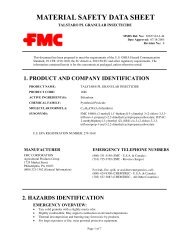
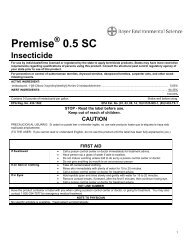
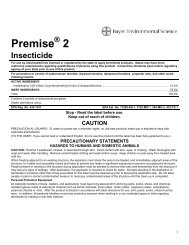
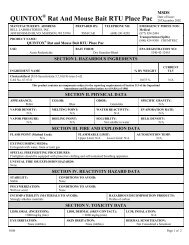
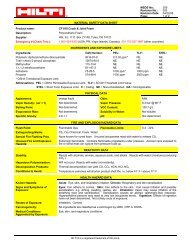
![master msds [msds] - Label](https://img.yumpu.com/41775487/1/190x245/master-msds-msds-label.jpg?quality=85)

